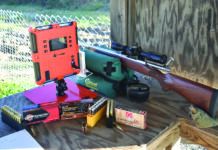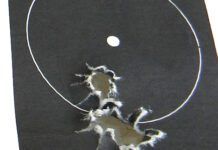After many years of soaking in the think tank, the Scout Rifle is here. If you know nothing about Jeff Cooper and his Scout Rifle, it means you probably haven’t read anything he has written in the last few years. When two gun enthusiasts get together, sooner or later the age-old question will pop up, “If you could have only one firearm, which one would it be?” Jeff Cooper has taken his answer to the next level by developing what he thinks is the only rifle you will ever need.
So, what is a Scout Rifle? In Mr. Cooper’s own words, “its a general-purpose weapon suitable for any use to which a rifle may be put, with the exception of the pachyderms and the buffalo.” The rifle’s manufacturer, Steyr, claims it can be used as a sporter, a tactical rifle or a survival rifle.
More specifically, the Steyr Scout Rifle is a .308 Winchester bolt-action repeater with a fluted 19-inch barrel. It has a composite stock and is topped with a Leupold fixed-power IER scope. The unit comes in a plastic carrying case and retails for $2,595.
[PDFCAP(1)].Recently, we obtained a Steyr Scout Rifle and put it through its paces to see if this was truly the only rifle we’d ever need.
The Lock
The matte black receiver of the Scout rifle was made of an aluminum alloy to meet one of Cooper’s requirements that the rifle be light weight. There was an integral scope mount rail toward the front of the receiver, which allowed the scope to be positioned either forward of the ejection port or in the conventional position.
Except for the matte black bolt handle, the bolt was left in the white. There was a double row of locking lugs at the front of the bolt. We were disappointed in the machining of the flutes cut into the bolt, which Steyr called ice and residue grooves. The tool marks in the flutes were deep, and the surface of the bolt that faced the ejection port showed signs of a lot of cutter chatter. The bolt handle was flat with an upswept end. A cocking indicator protruded from the rear of the bolt when it was cocked.
The primary safety, called the roller tang safety, was located on the tang of the receiver. It could only be engaged when the rifle was cocked or when the bolt was open. This safety had three positions. When the roller was rotated fully forward and a red dot was visible, it was in the Fire position. When the roller was rotated backward until a click could be felt and a white dot was visible, the safety was in the Loading position. When the roller was rotated backward until a gray lock popped up, it was in the Safe position. To move the roller from the Safe position, the gray lock had to be depressed while rotating the roller.
In addition to the tang safety, there was a “Double Lock/Safe” feature built into the SBS (Safe Bolt System) bolt. When the tang safety was in the Safe position, the bolt handle could be pushed down until it was flush with the stock. This locked the bolt and the firing pin. When the tang safety was moved to any of its other two positions, the bolt moved to the ready (normal) position.
The Scout Rifle was equipped with an adjustable two-stage trigger that had a smooth face. After about 1/4-inch of takeup, its pull broke cleanly at 3-3/4 pounds. This was one of the best factory triggers we have seen in a long time.
Two removable 5-shot magazines were provided with this rifle. The magazines’ bodies and followers were made of black plastic. There were dual locking levers on the sides of the magazines, near the bottom. The levers had to be pinched together to release the magazine from the rifle.
The Stock
Once the rifle was out of the carrying case, the eyes went straight to the gray stock. Made of Zytel, its design had a lot going for it. Starting at the back, there was a butt pad made of very hard black rubber. The pad was 1-1/2 inches thick at the toe (more on this later) and 1/2 inch thick at the heel. The heel was rounded to allow for rapid shouldering. To allow the shooter to adjust the stock’s length of pull, two removable black plastic 1/2-inch-thick spacers were positioned between the recoil pad and the buttstock.
In the bottom of the buttstock was a storage well for carrying a spare magazine. The pistol grip was relieved and afforded a very comfortable grasp. Inside the pistol grip was a hollow area that could be accessed by releasing its cover. The trigger guard was integral with the stock.
The magazine well had an innovative double-detent locking system. When the magazine was inserted to the second detent, the bolt could strip a round from the magazine. Inserting the magazine to the first detent moved it away from the bolt and allowed manual feeding of a round into the chamber. A true magazine cutoff it wasn’t, but the end result was the same.
At the forward end of the stock was the integral bipod. Its release lever was located on the bottom of the forend. Depressing the release unlocked the bipod legs, allowing them to be lowered and snapped into position one at a time. The bipod had a tilt capability that allowed the rifle to be canted 15 degrees on either side of vertical. On the underside of the forend was a mounting rail for the attachment of accessories, such as a flashlight, a laser sight or a different bipod.
At three positions — on the side of the buttstock, just forward of the magazine well, and under the forend —were flush-mounted sling attach-ment points for a sling. The sling and instructions for its use were furnished with the rifle.
The Barrel
The thin barrel was only 19 inches long and measured 0.526 inch in diameter at the muzzle. There were two sets of flutes milled into it. The front set protruded from under the front of the scope rail, while the second set was under the scope rail. The barrel ran under the scope rail and, as near as we could tell, was free floating.
The Scope
The optical sight provided with the Scout Rifle was a Leupold 2.5-power Intermediate Eye Relief scope with standard (slotted for a coin) windage and elevation adjustment dials. The manual supplied with the rifle stated the scope had an eye relief of 9.3 inches and a field of view of 22 feet at 100 yards. The duplex crosshairs were black and very heavy. The scope rings and base unit was made by Steyr.
At The Range
Once the rifle was out of the case and set on the bench, we stopped a lot of traffic on the firing line. Everyone that went by showed an interest in it.
During firing, there were several things we noticed. First, this 7-pound rifle had the felt recoil of a .300 Winchester Magnum. Second, the butt pad’s protruding toe dug into the lower portion of the shooter’s shoulder. This wasn’t a problem for the first couple of shots. But, by the end of the shooting session our chief tester, who is no slouch when it comes to shooting rifles, didn’t care if he saw another rifle for a while. Within two days, the bruise on his shoulder was tremendous.
We didn’t have a problem folding down the bipod, but we had a hard time using it. Each leg was 11-1/4 inches long and had no elevation adjustment. The height of the bipod wouldn’t allow us to use our shooting bench and see the target. So, we put the rifle on the ground—same problem. With the legs extended, and the barrel level with the ground, there was 9-1/2 inches of space under the rifle’s forend.
With the forward mounting of the scope, both eyes could be open during the shot. This took a little getting used to, but it was not as hard as it sounds. We thought the scope’s crosshairs were too heavy. They were very easy to find, but their thickness covered too much of a 100-yard target for our liking. The scope was very bright and crystal clear.
We fired the Scout for accuracy at 100 yards using the scope and three kinds of factory ammunition: Federal Gold Medal Match 168-grain boattail hollow points, Hornady TAP (Tactical Application Police) 168-grain boattail hollow points and Remington 180-grain Core-Lokt soft points.
The results were a little surprising. The Federal load performed very well, as we expected, producing two 3-shot groups under an inch—0.81 inch and 0.94 inch. The other groups measured from 1 .47 to 1.88 inches. The average of the five groups was 1.39 inches.
[PDFCAP(2)].The Remington load performed well. The smallest group measured 0.75 inch. The other groups ran from 1.49 to 2.01 inches. But, when we did the math, this hunting ammo beat the overall average of the Federal match load by 0.03 inches. Not by much, granted, but beat it just the same.
The Hornady load was the best of the bunch. It turned in one excellent group that measured 0.51 inch. The other groups ran from 1.05 to 1.95 inches. It produced a group average of 1.17 inches. We were very happy with this ammunition, though the recoil of the TAP ammunition was more pronounced than the other two.
Once accuracy testing was completed, we removed the scope and shot a few 100-yard groups using the rifle’s iron sights. One 3-shot group of 0.89 inch was obtained with the Remington load. We thought this was very good accuracy for iron sights and hunting ammunition.
The Bottom Line
Do we think Jeff Cooper and Steyr have created the only rifle you’ll ever need? Not really. Furthermore, we are not going to waste our time standing around Mr. Cooper’s trash can waiting for him to get rid of all his other rifles.
But, we do think the Scout is one of the most interesting rifles to come along in a long time. It is lightweight, has a radical but functional stock, and is very accurate. We also think that the price tag of $2,595 will run a lot of shooters off. Would we buy it? Probably not. For the same money, or less, nearly anyone could bring their own dream rifle into being.























